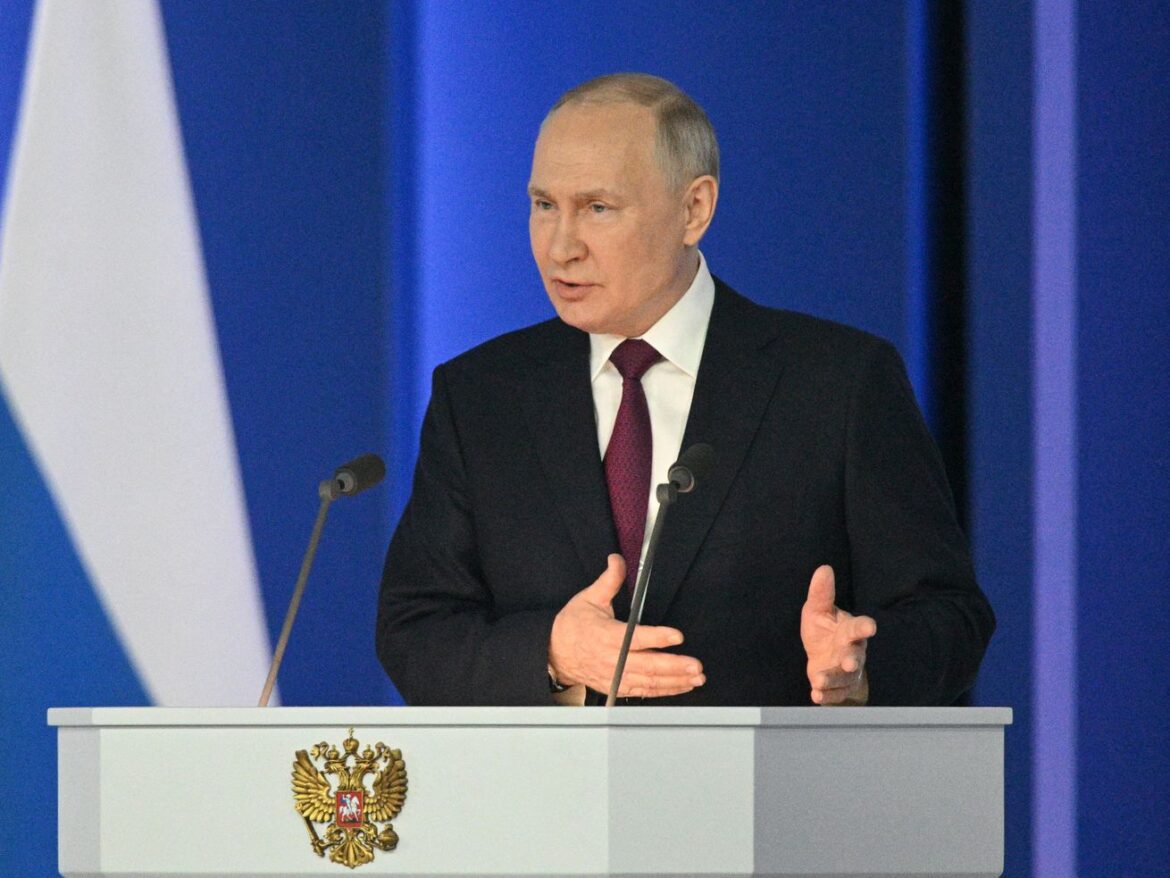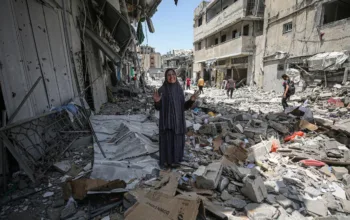Vladimir Putin is suspending New START amid Ukraine war tensions.
The last standing nuclear arms control treaty between Russia and the United States is in deep danger.
Russian President Vladimir Putin said this week that Russia was “suspending” its participation in the New Strategic Arms Reduction Treaty, or New START, which limits the number of deployed long-range nuclear weapons for each country. Putin made the announcement in a speech marking the first year of his war in Ukraine, and he effectively tied his decision to the conflict, saying Washington wants “to inflict a strategic defeat on us and claim our nuclear facilities.”
Putin’s decision is a distressing signal not just for New START but for global arms control and nonproliferation more broadly. Russia and the United States have the world’s largest nuclear weapons arsenals, and a pact like New START should serve as a safeguard during moments of tension, rather than a tool in a geopolitical standoff.
New START specifically caps the number of long-range missiles each country can deploy to 1,550 and allows for a maximum of 700 long-range missiles and bombers.
It all sounds very technical, but strategic nuclear arms are “the big intercontinental systems that are essentially an existential threat — not only to the United States and to the Russian Federation, but to the global community, to humanity as a whole,” said Rose Gottemoeller, who served as the chief negotiator in the Obama administration for the New START Treaty and is now the Steven C. Házy Lecturer at Stanford University.
Russia has said it is going to continue to follow the limits set out by New START — in other words, according to Moscow, it’s not going to amass more warheads. But beyond the nuke limits, New START has formal mechanisms for data-sharing and verification — including inspections — which give both the US and Russia transparency into what the other was doing, and brought stability and predictability to the nuclear relationship. The Biden administration renewed the pact with Russia in 2021, but the agreement is set to expire in 2026 unless a new deal can be negotiated. The prospects for a new deal were already pretty grim, even before the Ukraine war poisoned US-Russia relations even further.
Russia had been gumming up the pact even before Putin’s announcement this week. Inspections were paused during the pandemic, but Russia has continued to block them, most recently claiming that US sanctions are preventing Russian officials from conducting checks. (The US State Department says that’s not true.) Russia also bailed on technical talks, linking that to the US’s weapons support for Ukraine.
Russia’s so-called suspension isn’t actually a legal possibility under the treaty — but, then again, this isn’t exactly a good faith effort. Instead, Putin is trying to use New START as a bargaining chip in the Ukraine war. It’s another way for him “to impose costs or risks on the United States and the West, basically, saying: ‘We know you value this arms control treaty, but if you continue supporting Ukraine the way you are, you can say goodbye to that treaty’ — or he’s at least kind of hinting at the possibility that that could happen down the road,” said Nicholas Miller, nonproliferation expert and associate professor of government at Dartmouth University.
Putin has also used nuclear threats during the Ukraine war. The suspension of New START follows that playbook — an attempt to raise fears in the West about what Russia might do — in an effort to force the US and its partners to back off their support for Ukraine.
US Secretary of State Antony Blinken called Russia’s decision “deeply unfortunate and irresponsible,” but made it clear that the US wants to engage with Russia on arms control at any time, “irrespective of anything else going on in the world or in our relationship.”
In the past, Washington and Moscow have tried to separate talks on strategic nuclear arms from other issues, even if the rest of the relationship was a mess. That seems much less of a possibility now, which is trouble for the US-Russia relationship — and the entire world.
What happens if New START stops?
New START is the last of the bilateral arms control pacts between Washington and Moscow, as the rest of the architecture built from the Cold War onward unravels. New START was negotiated in the early years of the Obama administration, and officially went into force in February 2011. The treaty was set to expire in February 2021, but President Joe Biden and Putin agreed to extend it for five years, until February 2026, its current termination date.
Now, Putin has put the existing New START in jeopardy. The prospects of a follow-on treaty, however, were already pretty precarious even before the Ukraine war and Putin’s New START decision. “The pathway that we’re on is no different, but the slope is steeper,” said Amy Woolf, nonresident senior fellow at the Atlantic Council and former specialist on nuclear weapons at the Congressional Research Service.
The arms control agenda between Washington and Moscow has been stalled for some time; Russia and the US want different things. Also, any new New START would need to be ratified by the US Senate with a two-thirds majority, and good luck with that in the current US political environment.
“We’ve known for 10 years that our lists are very different, and we’ve been unable to reach any agreement on what should be on the table,” said Woolf. “If you think that Ukraine caused the problem, all Ukraine did was highlight the fact that there was already a problem.”
Both the US and Moscow had been chipping away at the arms control regime in recent years. The Trump administration withdrew from a few arms control agreements, including the Intermediate-Range Nuclear Forces Treaty (INF) and the Open Skies Treaty, which allowed for unarmed reconnaissance flights. The US had valid claims of Russian noncompliance, but both ended and left a vacuum behind. Some experts worry that this is Putin’s current modus operandi around New START: don’t comply, trample on the treaty, and force the US to withdraw, allowing Putin to blame Washington for tearing up the agreement.
So far, the United States’ tack has been to say they’re disappointed in Moscow but still open to finding a way out of this jam. Exactly what that means for the treaty going forward is unclear, but the most immediate risk is that both sides get a lot less clarity about what the other is doing with their nuclear arsenal. And we’ll know if that concern materializes pretty soon: The treaty calls for a biannual data exchange, and the next one is due March 1.
But even beyond that, New START provides both sides updates about what the other is doing — for example, if someone’s conducting a test or the US moves a missile out of a silo for repairs, it has to notify Russia about it. “Over time, that gives the Russians a great 24/7 view of the status and US Strategic Force posture,” Gottemoeller said. “That’s important for their security, it’s important for their stability; they understand exactly what’s going on in the US strategic nuclear arsenal.”
The same is true for the United States, of course. Once those updates don’t happen, the US and Russia will likely have to use other means to verify nuke limits. That is time-consuming, probably not as accurate (although both sides are allowed to use “national technical means” — like satellites — to verify information, and neither party is supposed to interfere with those), and also much more expensive. New START is “cost-saving,” said Jessica Rogers, impact fellow at the Federation of American Scientists. “You can use those resources for other things, or for other defense purposes.”
Without that information, the pressure could grow on both sides to build up the nuclear arsenals.
“Confidence in what’s going on in the Russian force will degrade. The voices arguing for an expansion of the US force because of what Russia is doing and what China’s doing will grow louder. And Russia will see what we’re doing and their voices to expand will grow louder,” said Woolf. “It’s a cascading effect over time — it’s not a concern that next week will pop out with an extra 1,000 warheads. That’s not going to happen.”
Experts caution that an immediate buildup by Russia is probably not the immediate threat. That takes time and money, and Russia has a lot going on. Again, at least for now, Putin has said that Russia will not increase its strategic nuclear arsenal beyond the current New START limits.
But even if an arms race isn’t an urgent worry, the potential for an arms free-for-all exists — not just between the US and Russia, but also China and other nuclear powers. Putin’s weakening of New START starts this process, and the treaty expiring might accelerate it.
“If 2026 rolls around and there’s no replacement, then there is a possibility that each country could substantially upload more nuclear weapons,” said Shannon Bugos, senior policy analyst at the Arms Control Association.
A grim moment for global arms control, in a series of tough moments
A renewed and unrestrained arms race is not an inevitable conclusion, but as the arms control regime erodes, the greater the risk becomes over time.
And if that happens now, it is not a reprise of the Cold War, with two superpowers, Russia and the United States, locked in competition. It is a much more multipolar world. Iran is inching closer to enriching weapons-grade uranium (something facilitated by the US throwing out the Iran Nuclear Deal). Even US allies like South Korea are more publicly debating getting nuclear weapons, worried about the threat from North Korea’s program.
But most critically, China, another superpower, is also in the mix. Beijing’s strategic nuclear arsenal is still far below either the US or Russia’s, but it is likely trying to build closer to their levels over the next decades — strategic nuclear arms levels currently fenced in by New START. If Russia and the US throw off the remaining restraints, it removes some of the incentive for China (who has been reluctant to engage bilaterally or multilaterally on arms control), or anyone else, to follow suit.
And once countries start down an arms-race path, it is hard to get off the ride. Trust is broken, and getting any agreement on arms control is much harder if tensions among parties are high. Once you invest in building up a nuclear arsenal, it’s not easy to shift, and it’s not cheap to dismantle nuclear warheads, either. And even if you’re a country that thinks some 1,500 strategic nuclear weapons is enough for your defense, sitting out an arms race with an adversary is a pretty hard sell when it comes to domestic politics.
Again, this is not happening at this moment, but chipping away at pacts like New START make that all the more possible. And often it takes a near-catastrophe — say, a Cuban missile crisis — for countries to acknowledge it’s in their national security to do arms control.
If anything, the Ukraine war should prove the need for Russia and the US to sit down on strategic arms, no matter what else. After all, that’s the point of these kinds of arms control treaties: They are supposed to provide guardrails when geopolitics are at a fever pitch because they help maintain a level of mutual trust and transparency that protects against miscalculation. They restrain powers when the impulse would be the opposite.
Which is also what’s so dangerous about Putin’s New START tactics. He is explicitly linking it to the US’s support for Ukraine in the war, which as Rogers pointed out, imperils not just arms control but international law more broadly.
Putin isn’t the only president who’s used treaties as a form of politics, but it adds to a troubling norm. By wielding New START as a cudgel, Putin is trying to escalate the nuclear risk, and get the US and the West to climb down from their Ukraine support. That ultimately makes the conflict more dangerous, adding uncertainty and even more mistrust — this time around weapons of mass destruction.



